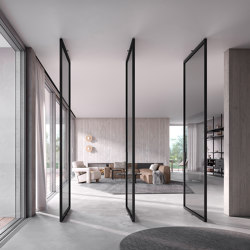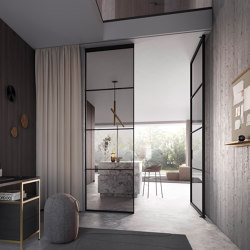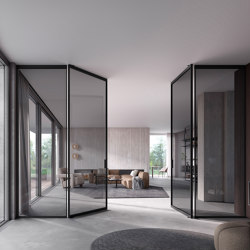The turning point for seamless interior transitions: pivot doors by Raumplus
Storia del Marchio di Markus Hieke
Bremen, Germania
29.11.24
Meeting the demand for flexibility in modern architecture, Raumplus pivot doors enable room concepts to flow seamlessly, providing a robust yet airy solution for subdividing interiors without compromising spatial connection.
Transparent pivot doors enable seamless room transitions, fostering flexibility and openness in interior design

Transparent pivot doors enable seamless room transitions, fostering flexibility and openness in interior design
×Transparent room boundaries in open-plan layouts have become increasingly popular over the years – both in work environments and at home. Spaces that are defined by function rather than separated by walls and doors foster a sense of community and trust. Nothing should happen in secret here. It strengthens the feeling of belonging and transparency when not everyone sits in their own area, only occasionally seeking contact with others. And yet there are moments when you wish for nothing more than just that: a door that provides a moment of separation, whether to remain undisturbed or simply to allow a moment of peace and concentration.
The S1200 pivot door by Raumplus stands out as a refined design feature, embodying elegance and minimalist sophistication

The S1200 pivot door by Raumplus stands out as a refined design feature, embodying elegance and minimalist sophistication
×Glass walls: a touch of lightness
A clever way of integrating doors without significantly compromising the room's open feel is to use floor-to-ceiling glass doors and walls, such as those offered in the Raumplus collection. These are especially effective when a loft-style interior is desired while maintaining the openness that characterises such spaces.
Pivot systems are primarily characterised by the fact that, unlike hinged doors, they do not swing around hinges on the doorframe
As a leading manufacturer of room dividers and door systems, Raumplus naturally knows how to create transitions between different areas of a space. Based in Bremen in northern Germany, the company recently added the S1200 pivot door to its range – a true eye-catcher shown here with a smoked glass panel. Pivot systems are primarily characterised by the fact that, unlike conventional doors, they do not swing around hinges in the doorframe. Instead, they are fixed to two points, one at the bottom and one at the top, slightly offset from the edge of the door. This typically asymmetrical pivot point, makes them look like swinging wall elements, giving them a refined elegance and minimalist aesthetic – along with other benefits that we would like to briefly summarise here.
Anchored at two points to the ceiling and floor, the pivot system allows for larger door dimensions than traditional systems, enhancing the sense of spaciousness

Anchored at two points to the ceiling and floor, the pivot system allows for larger door dimensions than traditional systems, enhancing the sense of spaciousness
×Strong principles, strong system
Pivot systems like the S1200 from Raumplus impress with their extraordinary design flexibility. Their appeal lies primarily in their modern and minimalist aesthetics. The pivot points anchored at the top and bottom allow for larger door sizes without visible hinges, creating an elegant and high-quality appearance. Additionally, they emphasise a clear yet unobtrusive spatial layout. Pivot doors visually separate and connect larger spaces in equal measure. With their pivot mechanism, they act less as a strict barrier and allow rooms to be designed flexibly. Because these doors are often wider and higher than standard doors, they can convey a feeling of spaciousness and openness. They are particularly suitable for rooms with high ceilings or open-plan concepts. Moreover, the swinging movement is often smoother and more impressive than conventional doors.
Pivot systems like the S1200 from Raumplus impress with their extraordinary design flexibility
Naturally, several practical benefits make a pivot system the preferred choice. However, the focus of the S1200 system by Raumplus is on an exceptionally elegant, manually operated pivoting motion that allows for easy and smooth operation. In contrast to conventional doors, which swing entirely in or out of the room, pivot doors, as mentioned, swing around a recessed pivot point. As a result, they take up less space when opened and are ideal for rooms with limited space. Pivot doors distribute the weight more evenly across the floor and ceiling structure, thereby reducing the load on the hinges, making the door more robust and, regarding more extensive and heavier sizes, more durable.
Offering customisable pivot positions and finishes, the S1200 pivot doors adapt seamlessly as room dividers or part of a door system

Offering customisable pivot positions and finishes, the S1200 pivot doors adapt seamlessly as room dividers or part of a door system
×Finally – what excites us most about the pivot door concept – they are an aesthetic highlight, an architectural statement. Their unique pivot mechanism and the option to use exceptional materials and finishes make them an eye-catching feature in any interior. The frame around the safety glass is exceptionally slim, allowing the S1200 pivot system by Raumplus to blend seamlessly into modern spaces. The panelling, which is available in various designs, can be optionally supplemented with muntin bars. This means there are virtually no limits to individualisation and possible interior applications. The S1200 pivot system can be used as a room door or divider, as a single or double door, as a sequence of doors or as an addition to the S1200 fixed element. In this way, rooms can continue to flow seamlessly, even when a glass wall discreetly divides them.
© Architonic
Head to the Architonic Magazine for more insights on the latest products, trends and practices in architecture and design.















